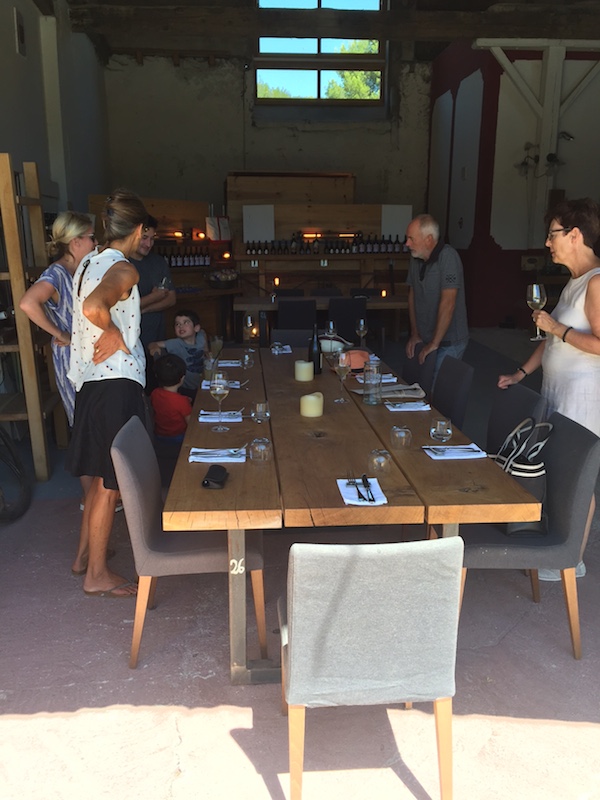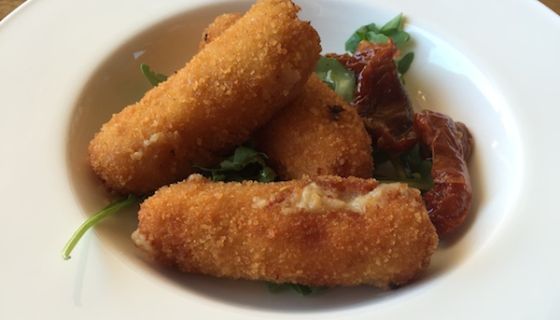20 August 2018 Nick and I have already enjoyed a couple of meals at the original Bourdasso this summer. The restaurant seems to be extremely popular and is mainly open in the evening – with ever extended buffalo herd for their beautiful mozzarella. But I should point out that the Bourdasso family have been invited to take over the restaurant at Domaine Gayda near Limoux (originally described in our 2010 guide to Eating out in Languedoc-Roussillon). We have not yet been to inspect but we are told that the Antonini family have installed a separate team at Gayda and it's chiefly open at lunch. Reports welcome.
20 August 2016 Up in the Corbières hills, which lead to the Pyrenees, the natural border between Spain and France, and no more than a 20-minute drive from the Cité of Carcassonne and equidistant between the villages of Montlaur and Monze and closest to the hamlet of Pradelles-en-Val, there is a most unexpected outpost of Italy.
The farm, which is not that easy to see from the road, has long been called Bourdasso. The property it occupies is the former winemaking facilities and house of the previous owners but the Italian influence is now obvious. The men wear predominantly white with their shirts conspicuously outside their trousers; the main dining room is stylishly simple and clean; and most crucially, and unusually for this part of the world, there is not a mention of cassoulet or confit du canard on the menu. The wine list even carries 10 different Italian red wines.
To explain how this unlikely combination came about, it is necessary to go back two and a half years. The family Antonini, led by their industrial designer father Fabio, was on holiday in the region. Fabio was accompanied by his wife Cinzia, son Edoardo, his fiancée Anastasia and Caroline, his youngest daughter. They fell in love with the area and the views, which still impress Fabio today, and they decided that it was time to pack up and leave their former lives in Rome. They made the trek lock, stock and barrel.
They started looking for a property and soon found Bourdasso, although with it came an obstacle: the vineyards. ‘We are definitely not grape growers', Fabio explained to me in their now very different cave, ‘so we had to wait until they had sold off their vineyards and then we could buy the property.’
Fabio’s industrial designer eye then took over. A modern kitchen was created next to the dining room. The height of the latter is an obvious setting for some impressive hanging lights, covered in striking Catalan stripes from Les Toiles du Soleil in nearby Perpignan; and the two cellars at the back of the dining room have been turned into adjuncts for the restaurant service; one holds the wine fridges while the other contains the coffee station. Then Fabio turned his attention to the main cave next door.
This, as the photo below may – just – suggest, has been turned to very good commercial effect with the minimum of intervention. The immobile (and now fashionable) cement cuves have been painted red and white; there is a large area in front of them, cool and inviting, which provides a perfect space for large parties, whether for weddings or other kinds of private and commercial ends. And when the space is not being used for such an event, a large, thick, wooden table made by Fabio himself from offcuts, accommodating up to 12, has pride of place. It is very chic – arguably shabby chic, but extremely thoughtful chic.

There is in addition a large terrace outside, too hot for anyone to sit at during the day but where aperitifs and food are served as the sun sets on the hills opposite. Large red cast-iron rounds from SAFA, one of Carcassonne’s oldest foundries, grace many of the walls along with numerous items of more commercial intent: packets of Italian pasta, olive oil, Bourdasso T shirts and aprons are for sale. A very fine stage set indeed has been created.
However, as so often with such restaurants, the menu is a fairly simple affair. There are a couple of antipasti (less than €10 each), two primi (€14-17), two main courses (around €20) and three desserts (each €8), including one plate of cheese. On our last visit, a Saturday lunchtime, the starters included a small home-made burger bun that had been infused with squid ink that held several large and salty sardines and a couple of sun dried tomatoes; a round dish stuffed full of croquettes of potatoes and mortadella that had then been deep fried so that their outsides were a golden brown while their interior was a mellow, hot, creamy mess. Finally, there was a proper panzanella, the hearty Italian salad that incorporates leftover bread, tomatoes, onions and basil but must never be too liquid.
I have to admit that neither I, nor anyone in our party on the several occasions we have eaten here, has ever got past the primi course, mainly because dishes at the beginning of the meal are so good. The second is because it has been so hot that this course, together with an antipasto and a sweet course, has seemed more than enough. And thirdly the starters and pastas are all so interesting. On the last occasion a dish described as pasta al forno alla Bolognese, basically giant penne rigata smothered in a rich meat sauce and then baked in the oven, was good enough to delight our five-year-old grandson and his much older grandmother.

So too were two other primi dishes, an excellent risotto with saffron from the Domaine de Cantalauze in the Tarn topped with parmesan, beetroot fronds and crisp bacon and a very good rendition of the classic parmigiana de melanzane, that liquid mix of aubergines and tomatoes topped with parmesan cheese. Desserts, Anastasia’s responsibility, are invariably straightforward versions of classics: a panna cotta topped with fresh apricots; a luscious semifreddo tiramisu; and a tart with cream and pine nuts.
There are several reasons for visiting Bourdasso. To reward the Antoninis' courage and vision; to encourage the family in what has been probably a bigger challenge than they envisaged – and certainly the current drought is making the breeding and rearing of their 30 head of buffalo that roam close by (from which they currently serve and sell the meat, although the anticipated mozzarella production is somewhat behind schedule); and to enjoy the views, the food, the wine and the very friendly service.
But the best reason to book at Bourdasso is quite basic. It is because it is there, an outpost of Italian style on the border of France and Spain.
Bourdasso Cucina Italiana 11220 Pradelles en Val, Aude; tel +33 (0)4 68 78 08 31; bourdasso@hotmail.com













